Florida has a unique climate and can grow a wide range of fruit trees.
What fruit trees grow well in Florida? Apples, Avocado, Bananas, Citrus, Figs, Guava, Jackfruit, Japanese Persimmons, Loquats, Lychee, Mangoes, Mulberries, Papayas, Peaches, and Tamarind all grow well in Florida.
We have a tropical, subtropical and temperate climate here in Florida. North Florida sees plenty of chilly nights while south Florida sees a warm humid climate most of the year.
This unique climate range gives us a wide variety of fruit trees to grow. some will be easier to grow in the north while others will be easy to grow in the south.
15 Fruit Trees That Grow Well In Florida
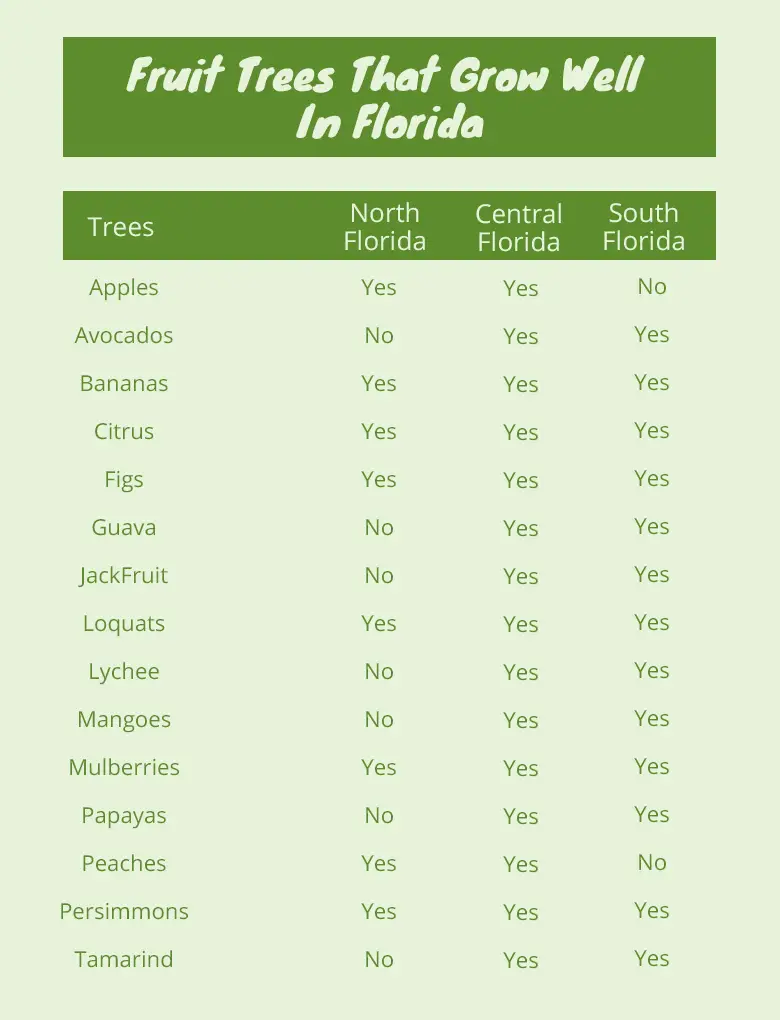
Important For Growing Fruit trees
Some fruit trees on this list will need a certain amount of cold weather in order to begin to set fruit. These are called chill hours.
A chill hour counts when the temperature is between 32-45°F. Those in the deep south Florida will have a really hard time getting these hours and will not be able to grow some of these trees.
Don’t worry though, south Florida has no shortage of fruit that trees it an grow.
Take a look at this chart to get an idea of how many chill hours your area gets
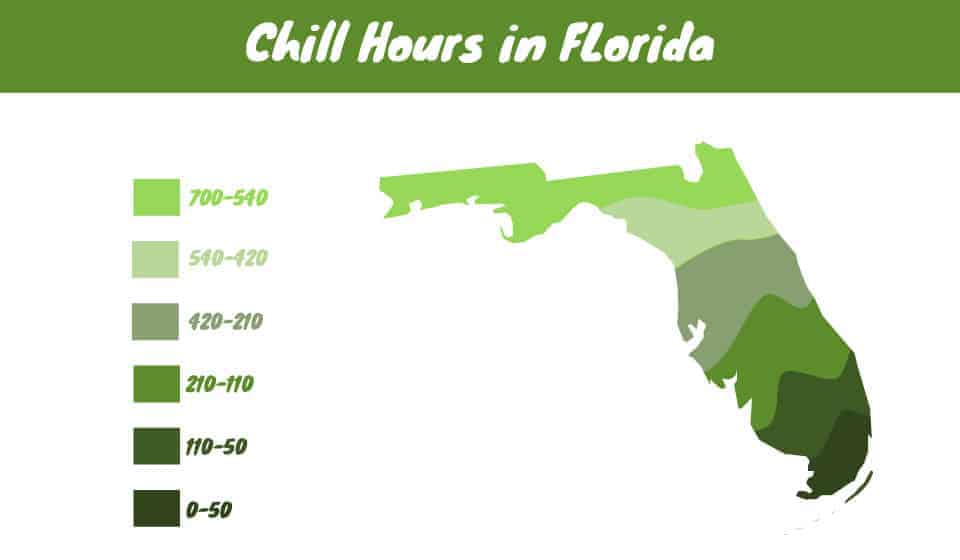
Apples
Apples are a fruit tree that need a certain number of chill hours in order to set fruit. These will only grow well in north and northern central Florida.
Growing apples is relatively new to Florida. A low chill hour variety of apple right now is about 300-400 chill hours. This isn’t a possibility for lower central and south Florida.
Florida Friendly Apple Varieties: Anna, Dorsett Golden, and Tropic Sweet.
I order for apple trees to set fruit they need to be cross pollinated. This means you will have to have more than one apple tree in order to get fruit.
If growing from seed your tree will take some time in order to produce fruit. It usually takes seed grown trees anywhere from 6-10 years to begin producing fruit. If you have a grafted tree they will produce at a much younger age. Usually between 3-5 years old.
Apples normally ripen in Florida around June or July.
Avocados
Avocados are like the opposite of apples. They prefer warm weather and don’t really like the cold. However, there are new cold tolerant varieties being made that allow north Florida gardeners the chance to grow them.
Florida Friendly Avocado Varieties: Bernicker, Brogdon, Choquette, Day, Hall, Lula, Marcu Pumpkin, Mexicola, Monroe, Pollack, Russel, Simmonds, Winter.
Brogdon, Choquette, Day, Mexicola, and Winter all have a high cold tolerance. This means that they can withstand temperatures in between 20-30°F.
The trees must be mature in order to withstand these temps. It’s a good idea to give young Avocado trees plenty of cover when cold weather rolls in.
Avocado trees can grow up to 60 feet tall depending on the variety but it becomes rather hard to pick the fruit when trees are that tall. Keeping them at a manageable size with pruning is a good idea.
The fruits actually don’t ripen on the tree. The best avocado will ripen in about 4 days after picking. If your avocado rots before it feels ready for eating that means that the fruit needs to stay on the tree a little longer.
The time at which they ripen will depending on the variety of avocado tree. You can get multiple varieties of avocado so that you can have a continuous harvest of this great fruit.
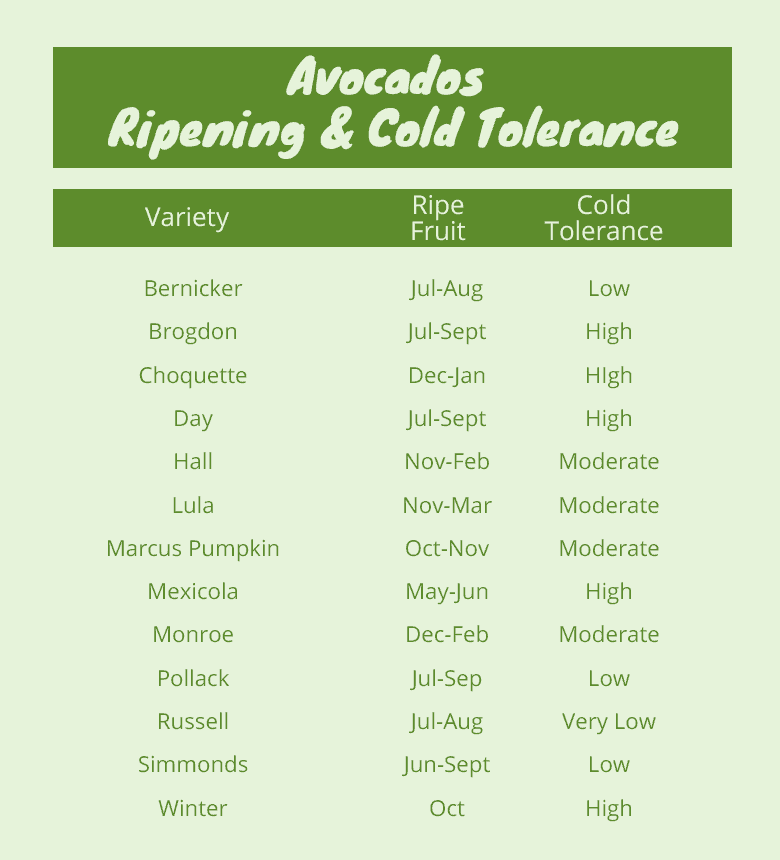
Bananas
Bananas are not only great for their fruit but they are also beautiful plants. They are another plant that prefers the warm weather. Central and South Florida will have no problems growing bananas year round. but Cold temperatures do knock the banana plant to the ground, but it should grow back when the temperatures rise
Banana plants enjoy our warm and moist summer. They are a tropical plant. The best to time plant a new banana tree in Florida is mid to late spring when the weather warms up and afternoon storms become regular.
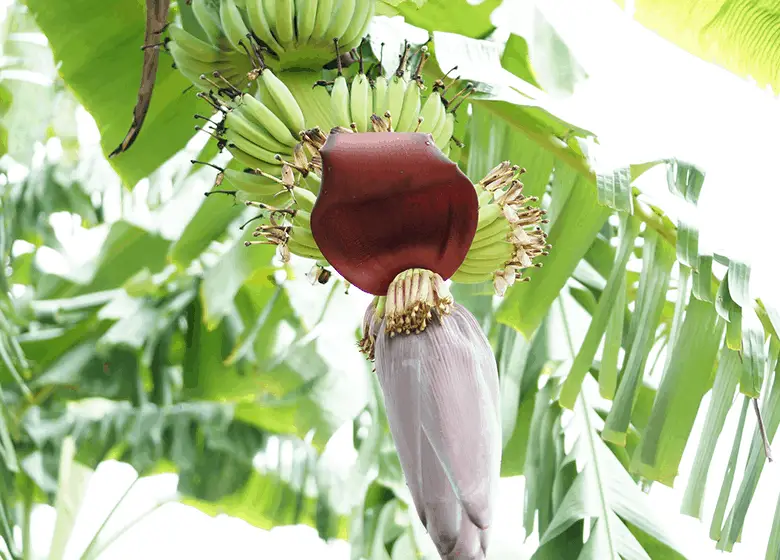
There are lots of different varieties of banana. The ones in the supermarket are usually just one or two different kinds. Bananas come in lots of different colors and sizes.
Florida Friendly Banana Varieties: Apple, Blue Java, Dwarf Cavendish, Dwarf Orinoco, Dwarf Red, Gold Finger, Ice Cream, Lady Finger, Mysore, Williams.
Ice cream bananas are really y cold resistant, Those in north Florida will probably have the best luck with those.
Different varieties will grow to different heights. the dwarf varieties will usually grow between 6-9 feet while the other varieties can get up to 14 feet tall.
All bananas enjoy full sun and well draining soil. If their roots stay soaked they will die.
Citrus
Citrus is probably the first fruit tree that comes to mind when you think of Florida. Oranges, Lemons, Limes, Grapefruits, Key limes and Tangelos. Florida’s climate can support all of these fruits.
However, there has been a serious issue affecting commercial citrus production and that is a disease called citrus greening. It is spread by infected bugs, soil, and equipment. It is a huge issue and it has the industry struggling.
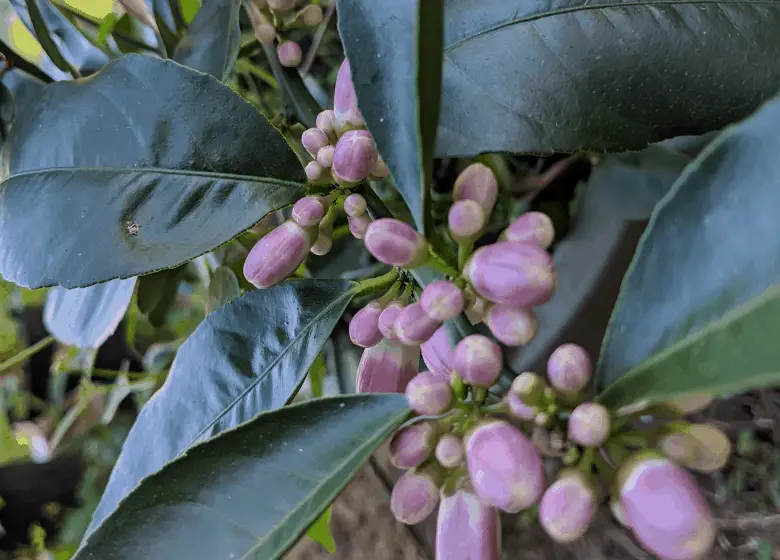
However, this does not mean that we can not grow our own citrus trees in the backyard. Citrus is a subtropical fruit and is damaged by freezing weather. Those in north Florida will have to provide protection for your plant on the colder nights of the year.
Navel oranges are probably the most popular variety of organge we can grow in Florida. Tangelos are a cross between a grapefruit and a tangerine. Popular varieties are Orlando and Honey bells. Tangelos are actually cold hardy.
Myer lemons are another example of cold hardy citrus that north Floridians can grow. Key limes on the other hand can not tolerate any frost and should only be grown in the southern parts of the state.
Lots of times you can find cocktail plants at your local nurseries. These are root stock plants that have had a couple of different kinds of citrus grafted on to them.
Citrus trees prefer full sun with a well draining soil. They can grow up to 15 feet tall and wide so give them plenty of space to spread. If you are growing your trees in containers they will still grow just fine but their mature size will be much smaller.
Figs
Really good fresh figs are hard to get at your supermarket, the fruits don’t do well with all the logistics.
For this reason a homegrown fig might be the tastiest fig you will ever eat.
Figs are an easy fruit to grow in Florida. They prefer full sun and Plenty of room to grow. Figs can get 12-15 feet tall and the same wide.
The best variety of fig that you can grow in Florida is ‘Celeste’. ‘Brown Turkey’ is another popular variety in Florida as well.
I think Celeste is better because the fruit is formed with a closed end. Brown Turkey figs, on the other hand have a hole in the bottom of them. This gives a nice home for bugs to grow in.
It’s not the end of the world, Brown Turkey figs grow fantastic in Florida, but it’s just an extra thing to be aware of and I would rather not worry about whether or not I washed this fruit good enough before eating.
If you are planting from a tiny cutting or seed the best time to plant figs in Florida is March.
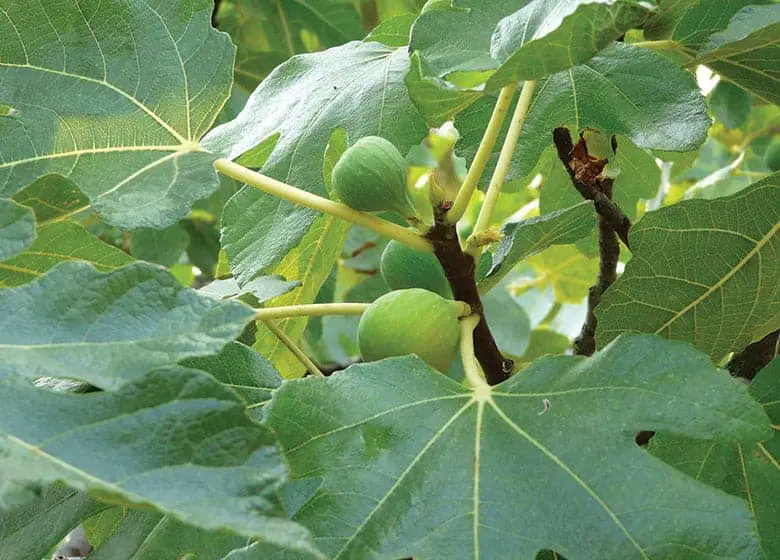
The early springtime will give your tree the best conditions to thrive. However, if you have a mature tree you can plant it at almost any time of year. But I would avoid the hottest and coldest months of the year.
Figs take a few years of growth before they start producing. Both varieties will start to ripen around July and continue to ripen for the next few months.
There seems to be some debate as to whether fig trees need chill hours or not to ripen. There are some sites that say they do and others that say they don’t. I’m in central Florida and I see fig trees with lots of fruits all around me.
If you’re in south Florida and are growing figs just fine join in on the discussion in the comments below. What varieties are you growing and how are they doing?
For more on growing figs in Florida check out this post.
Guava
Guava might not be the most desired fruit on this list but a freshly grownn, freshly picked guava fruit tastes like a sweetened pear. It does not have a texture of a pear, the texture is much more dense and creamy.
Guava is native to tropical America, so it grows well in south Florida and central Florida. North Florida’s cold weather will kill this tree. Temperatures lower than 27F will kill a mature guava.
Fruit production and plant growth stops at 60F. Guava trees can grow up to 12-15 tall and wide.
There are two types of guava fruits, pink/red and white guava. White varieties are a little more tart than pink guava. Pink guava is sweet and extremely fragrant when ripe.
Florida Friendly Guava Varieties:
- Pink/Red Guava – Barbi Pink, Hong Kong Pink, Patillo, and Homestead(Most popular)
- White Guava – Crystal, Lotus, Supreme, Webber
Guava trees need a well draining soil, especially for our wet Florida summers. Guava trees do not like their roots to be wet for very long. It is a plant that tolerates drought very well.
You should also pick a spot where your guava gets plenty of sun. Guava trees do not do well in part shade, you will get much more fruit from a tree that is grown with plenty of sunshine.
Pick fruits that are firm but have a little give when you squeeze them. As the fruits ripen they change from a green color to a yellow color.
Jackfruit
Jackfruit trees are definitely for south Florida gardeners.
Temperatures at 32F will start damaging this tree. Anything lower than 28F will kill a jackfruit tree. This tree would not be an option for those in north Florida unless you can provide adequate protection, like a large greenhouse.
The jackfruit tree can make fruits up to 60lbs! This doesn’t mean that all of your fruit will be massive. They more commonly weight in the 10 – 20 lbs range. The variety will affect the size of the fruit as well.
Florida Friendly Jackfruit Varieties:
- Black Gold
- Cheena
- Chompa Gob
- Cochin
- Dang Rasimi
- Golden Nugget
- Honey Gold
- J-30
- J-31
- Lemon Gold
- Ns-1
- Tabouey
The tree itself can grow between will grow between 18-40 feet tall. It is best to prune your jackfruit tree in order to make harvesting easier and to keep them at a manageable size.
Varieties Black Gold, Cheena, Chompa Gob, and Gold Nugget can be pruned and still happily produce when they are kept at around 8 feet tall.
Jackfruit doesn’t really mind our Florida soil. Sandy soil doesn’t seem to bother them but beefing up the soil will make them happier.
Plant jackfruit trees in Full sun.
It’s always much quicker to get fruit when you buy a nursery grown plant but if you plan on planting from seed you should expect fruit in years 3-4 of growing.
Loquats
Loquat trees can be grown across all part of the state. These trees can take south Florida’s tropical climate but they can also take freezing temperatures. Loquats really are an amazing tree.
They are also beautiful and used for landscaping purposes. They have large attractive foliage and bright little bursts of white flowers with orangish fruits that give this tree an appealing look.
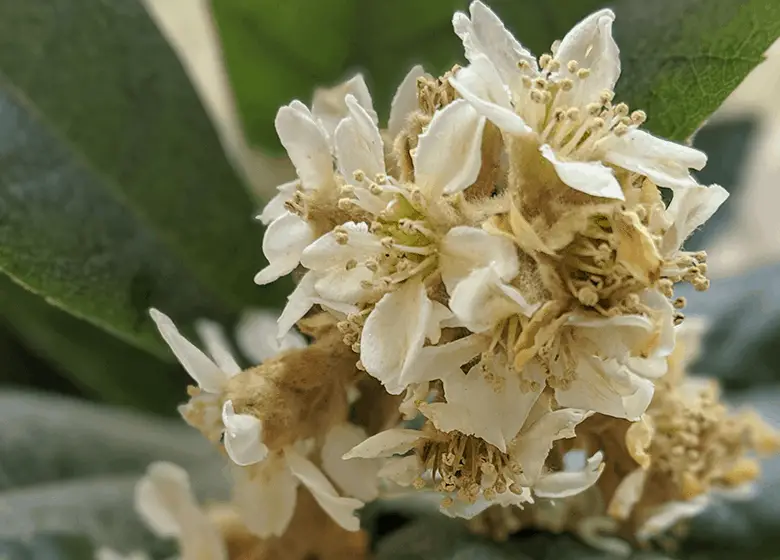
When I learned about loquat trees and started looking around I noticed them all over the place near me. Lots of them on the side of the road and in plenty of yards. They are so easy to grow here in Florida that they don’t really require any extra irrigation or care once established.
If you start to notice some loquat trees around you and get the smart idea of picking a fruit and planting a seed you should know that the tree doesn’t grow true from seed. This means you may get a different variety of loquat than the mother plant. One that may produce less fruit or different tasting fruit or no fruit at all.
This is not a big deal if you plan to only use this tree as an ornamental but I say why not get the best of both worlds? If you are buying a loquat from a nursery make sure that it has been grafted.
Florida Friendly Loquat Varieties:
- Advanced
- Champagne
- Emanuel
- Golden Nugget
- Goliath
- Juda
- Judith
- Oliver
- Tanaka
- Thales
- Thursby
- Wolfe
If you want more info on growing loquats in Florida check out this post, it has all you need to know about growing them in Florida.
Lychee
If you’ve never heard of lychee you aren’t alone. This is a lesser known fruit on this list. It is a bright red fruit that is shaped kind of like a strawberry. It has a thick bumpy skin and the edible part is reached by peeling this skin off.
The edible part is sweet and clear. the texture is like that of a firm jello.
The fruits are grown in clusters on the tree and can be anywhere form 3 – 50 fruit large.
Lychee is a plant that will thrive in Central and South Florida. It is a tropical to subtropical plant. Temperatures at 24F will severely damage or even kill a mature tree. Tree damage starts at 32F.
The two most popular varieties in Florida are Brewster and Mauritius. Mauritius produces more fruit than the brewster variety.
Lychee is a plant that loves full sun and well draining soil. It will not tolerate its roots being in water for very long. It is a semi drought tolerant but young plants enjoy regular watering.
Lychees do not grow true from seed. The most common commercial way of making new lychee trees is by air layering. I’d never heard of this before and it’s a really interesting way of propagating plants that don’t do well from cuttings.
Mangoes
Mangoes are another central and south Florida loving tree. Much like the loquat tree, mangoes are a beautiful tree that could be grown just for how attractive it is in the garden.
You can still grow a mango tree in north Florida if you plant in a large container are diligent enough to bring it into a greenhouse or protected area when nights get cold.
You can also try protecting your mango by planting it in an area close to the south side of a building and by planting a nice layer of plants around it to protect it.
Mature trees can take temperatures down to 25F but younger trees will be killed by temperatures lower than 30F.
Avoid planting mangoes during the coldest time of the year.
Florida Friendly Mango Varieties: Carrie Atkins, Dunkin, Edward, Keitt, Parvin, Floridian, and Van Dyke
Mango trees begin to flower in December and go through April. They need insects in order to pollinate.
Mango trees need full sun and once mature don’t really need regular watering.
You can grow a mango tree from seed but this plant can also be grown from a cutting or by being grafted.
Mulberries
Mulberry trees can be grown accross all parts of the state. It can grow in the deep south where it’s hot and humid but they can also withstand a north Florida winter.
They aren’t picky about soil, actually, they seem to enjoy being planted into the ground here.
If you want to talk about a plant that produces a ton of fruit, this is one of them. I bet you’ll have a hard time getting rid of all the fruit that you get on this thing.
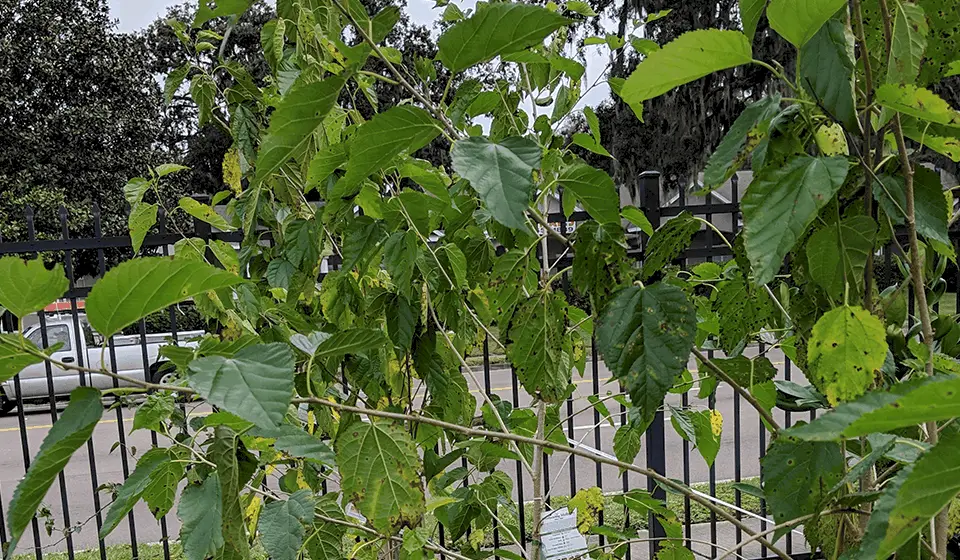
It’s best to start mulberry trees as cuttings. You can expect fruit within the first 1-2 years this way. If you grow from a seed you will have to wait at least double to triple that.
Mullberries enjoy a good pruning and they are grow well as a shrub.
I think the best variety of mulberry is the Pakistan Mulberry. It makes long, weird looking fruits but they taste similar to a raspberry. The ebst thing about the Pakistan mulberry (Besides how hardy it is) is that the fruits do not stain.
Many homeowners have complained about mulberry fruits staining sidewalks and other things around the house.
If you’re really into berries, check out this post about the best berries to grow in Florida.
Papayas
Papayas are really interesting fruits in terms of texture and flavor. They are often compared to cantaloupes in terms of flavor and texture.
As far as growing papayas you might not find an easier fruit tree to grow in Florida. Provided with enough water and plenty of sun you will have no problem growing papayas in central and south Florida.
Florida Friendly Papaya Varieties: Maradol, Red Lady, Solo Types
Papayas are damaged by light frosts, they can be grown in containers as long as they are at least 30 inches in diameter. So those in north Florida could potentially grow papayas if you had the ability to protect a large potted plant during the winter.
Papaya plants normally grow about 10-15 feet tall and produce fruit for about 4 years. After that fruit production begins to decline.
Papaya plants can be Male, Female or both Male and female. The female plants bear the fruit, but need pollination. If you are growing from seed its best to plant more than one plant in order to increase your chance for both sexes.
If buying from a nursery they will probably know the sex of the plant.
Peaches
Peaches are another fruit tree that requires a certain number of chill hours in order to set fruit.
There are a number of varieties that are Florida friendly and require a low number of chill hours. North Florida will have no problem growing any of these peach trees. Central Florida will have to be pickier when it comes to which variety they can grow. Those in deep south Florida may be out of luck until we can make no chill hour variety peaches.
But your location may vary.
Never say never. If you are in south Florida and have peaches growing let us know how they are doing in the comments below.
- Florida Glo and Florida Prince are low chill hour peach varieties that will do well in most parts of the state. These varieties will need 150 chill hours to set fruit.
- UF Best is an even lower chill hour variety needing only 100 chilly hours.
There are other varieties of peach trees that can be grown in Florida but I think these three mentioned will do well for the majority of the state.
If you want to know of other varieties of peaches and the number of chill hours your location receives check out this post on peach trees for Florida.
Peaches enjoy full sun and a well draining soil. Peaches do require a little pruning in order to maximize fruit production. Trimming them into a vase like structure gives you the best opportunity for lots and lots of fruit.
Persimmons
Asian varieties of persimmon are way more desireable than the native American varieties. The taste is much much better.
The Asian varieties will only grow to about 10 feet tall while the native American varieties will grow to be about 30 feet tall. These trees do well in full sun and a well-drained soil.
There are two types of popular persimmons, Astringent and non astringent. Astringent varieties are usually grown for drying fruit and non astringent are better suited to easting fresh. Non astringent are the more popularly grown ones.
Florida Friendly Persimmon Varieties:
- Astringent: Giombo, Ormond, Saijo, Sheng, Tenenashi
- Non-Astringent: Fuyu, Hana Fuyu, Izu, Suruga
It’s important to eat your persimmon only when ripe. If you eat this fruit before it’s ready I highly doubt that you will ever want to eat one again. Fuyu persimmons can be eaten while still firm but persimmons are best to eat when they feel pretty mushy.
Tamarind
Tamarind grows easily, almost like a weed in south Florida. This is not a tree for north Florida gardeners. Trees are easy to grow from seed. However, they also don’t produce true from seed so you will not know what kind of fruit quality to expect.
It’s best to get grafted or air layered trees. There are two types of tamarind, a sweet kind, and a sour kind. Sour tamarinds are used more for cooking and sweet tamarinds can be eatent fresh.
All Tamarinds come in a hard shell and inside (the sweet kind) the fruit tastes like a sweet prune. Be careful when eating fresh tamarind, There are seeds inside that you probably don’t want to bite through.
Usually nurseries aren’t anymore specific than sweet or sour tamarind when it comes to variety.
Tamarind trees are long-lived, they can live up to 200 years. They can also grow rather large, up to 100 feet tall. These are extreme cases of course but this tree would be perfect for a large shade tree in a Florida food forest.
Fruits usually mature in April through July. Heavy rains can damage fruit, so if you know that heavy rains are on the way you should harvest your fruit.
Planting Fruit Trees
When it comes to planting all trees it is always a good idea to dig a hole that is at least twice the size of the root ball. This gives the roots plenty of lose soil to work with.
Its good to backfill the hole you just dug with some of the dirt you took out and compost. you want to fill it just enough so that the trees trunk will not settle below the soil line.
Give the plant about an inch or so to count for settling of the dirt.
Soil around the base invites disease and problems to your plant. So just make sure that the base of your plant is not completely covered in dirt.
you should still have some dirt leftover from digging your hole. Use that dirt to build a ring a few feet away from your tree. This helps retain water.
And as always, mulching is on the list. Super big fan of mulch!
Building Fruit Tree Guilds
A fruit tree guild is a group of plants that are purposefully planted together in order to maximize yield and space.
There is usually a central element(A fruit tree) that things are then planted around. It’s a way of designing your garden that copies nature.
The first step to deciding what your fruit tree guild will look like is knowing how much space you are working with. A smaller fruit tree guild should have a smaller main element. For instance, if you have a small space to work with you don’t want to deal with an 80-foot tall tamarind in the future. Sure, shes small now but in a few short years she’s gonna be a big girl. You should choose a smaller tree like a Mulberry or something as your main element.
And then plant around it other plants that will benefit you and this tree in someway. That can be another food source for you, or it can act as a fertilizer for the soil and a living mulch for the tree. These other plants could attract beneficial insects and they could just look really pretty.
You can have a ground cover layer, a shrub layer, an herbacious layer, a vine layer, an upper canopy layer , and a lower canopy layer. With fruit tree guilds it’s all about craming as much beneficial plant diversity as you can.
If you want to learn more about fruit tree guilds and building a Florida food forest you will definitely be interested in this post:
